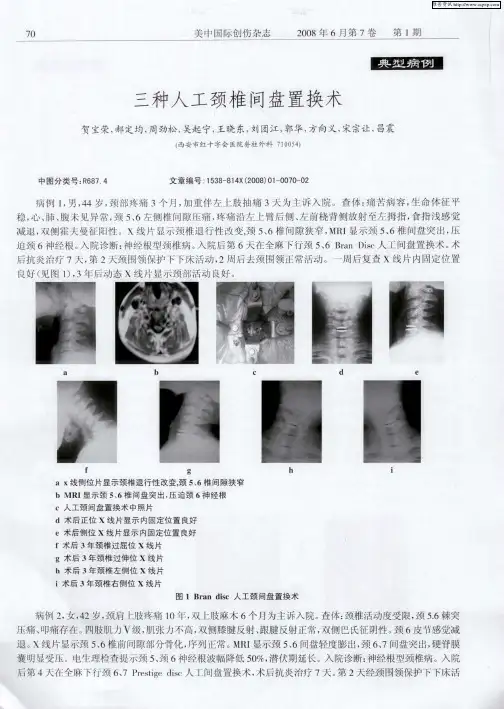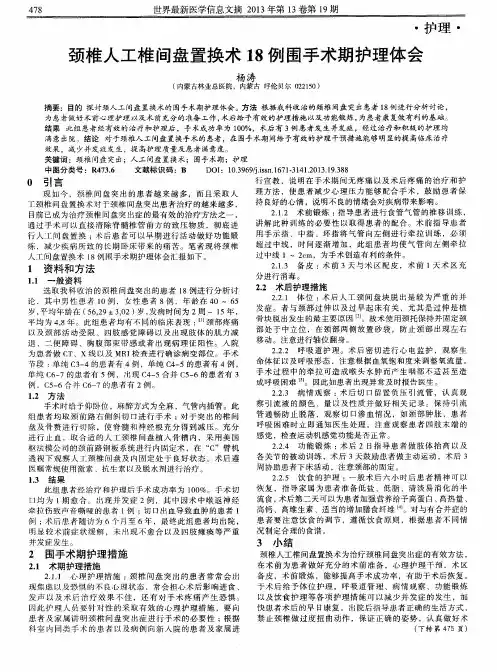颈椎人工间盘
- 格式:pptx
- 大小:28.89 MB
- 文档页数:55
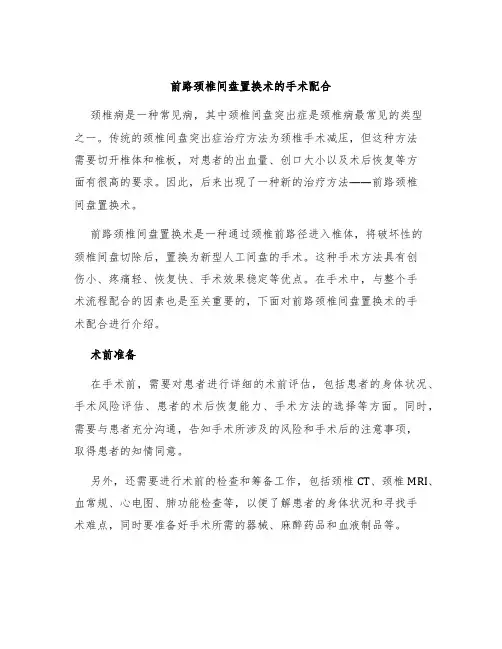
前路颈椎间盘置换术的手术配合颈椎病是一种常见病,其中颈椎间盘突出症是颈椎病最常见的类型之一。
传统的颈椎间盘突出症治疗方法为颈椎手术减压,但这种方法需要切开椎体和椎板,对患者的出血量、创口大小以及术后恢复等方面有很高的要求。
因此,后来出现了一种新的治疗方法——前路颈椎间盘置换术。
前路颈椎间盘置换术是一种通过颈椎前路径进入椎体,将破坏性的颈椎间盘切除后,置换为新型人工间盘的手术。
这种手术方法具有创伤小、疼痛轻、恢复快、手术效果稳定等优点。
在手术中,与整个手术流程配合的因素也是至关重要的,下面对前路颈椎间盘置换术的手术配合进行介绍。
术前准备在手术前,需要对患者进行详细的术前评估,包括患者的身体状况、手术风险评估、患者的术后恢复能力、手术方法的选择等方面。
同时,需要与患者充分沟通,告知手术所涉及的风险和手术后的注意事项,取得患者的知情同意。
另外,还需要进行术前的检查和筹备工作,包括颈椎CT、颈椎MRI、血常规、心电图、肺功能检查等,以便了解患者的身体状况和寻找手术难点,同时要准备好手术所需的器械、麻醉药品和血液制品等。
前路颈椎间盘置换术的手术操作一般分为以下几个步骤:切口首先,在颈部前方做一个横向切口,大约长3-4cm,暴露出颈椎前方的软组织。
松解前部软组织将颈部前方的肌肉、筋膜、血管等软组织逐层松解,露出颈椎前面的椎体和椎间盘。
切除间盘用手术刀沿着颈椎前方的椎体切开椎间盘,将破坏性的颈椎间盘切除。
置换新间盘将人造间盘放入椎间隙,并通过锁定装置固定间盘,使其在椎体之间保持稳定。
关切口手术结束后,将手术切口缝合,结束手术。
在手术中要注意操作规范,遵守手术流程,减少出血、神经损伤等意外情况的发生。
术后护理是前路颈椎间盘置换术的关键时期,必须严格按照医生的要求进行护理。
术后患者需要平躺卧床,避免颈部过度活动,防止引起切口裂开,同时还需要进行定期的随访,了解患者的病情变化并及时处理,以保证手术效果。
除此之外,还需要进行冷热敷、物理治疗等一系列术后恢复措施,加速患者的恢复。

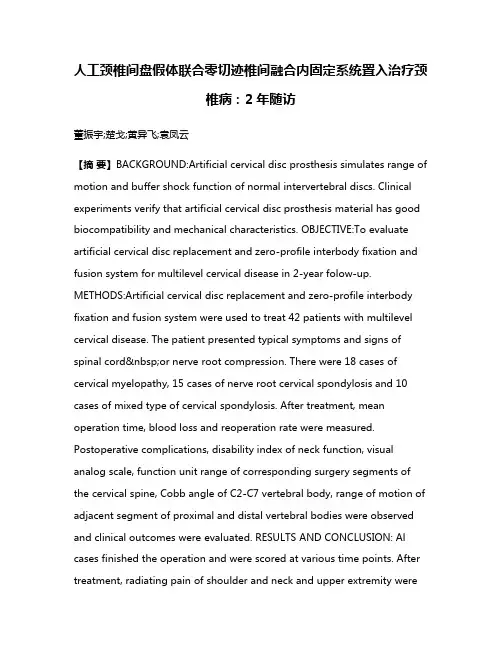
人工颈椎间盘假体联合零切迹椎间融合内固定系统置入治疗颈椎病:2年随访董振宇;楚戈;黄异飞;袁凤云【摘要】BACKGROUND:Artificial cervical disc prosthesis simulates range of motion and buffer shock function of normal intervertebral discs. Clinical experiments verify that artificial cervical disc prosthesis material has good biocompatibility and mechanical characteristics. OBJECTIVE:To evaluate artificial cervical disc replacement and zero-profile interbody fixation and fusion system for multilevel cervical disease in 2-year folow-up. METHODS:Artificial cervical disc replacement and zero-profile interbody fixation and fusion system were used to treat 42 patients with multilevel cervical disease. The patient presented typical symptoms and signs of spinal cord or nerve root compression. There were 18 cases of cervical myelopathy, 15 cases of nerve root cervical spondylosis and 10 cases of mixed type of cervical spondylosis. After treatment, mean operation time, blood loss and reoperation rate were measured. Postoperative complications, disability index of neck function, visual analog scale, function unit range of corresponding surgery segments of the cervical spine, Cobb angle of C2-C7 vertebral body, range of motion of adjacent segment of proximal and distal vertebral bodies were observed and clinical outcomes were evaluated. RESULTS AND CONCLUSION: Al cases finished the operation and were scored at various time points. After treatment, radiating pain of shoulder and neck and upper extremity wereremarkably lessened. Numbness and sensory loss symptoms disappeared obviously. Quality of life elevated noticeably. Visual analog scale and the disability index of neck function score were decreased in final folow-up compared with pre-treatment (P < 0.001). C2-C7 vertebrae Cobb angle, FSU angle, range of motion of proximal surgery adjacent segment and range of motion of the distal surgery adjacent segment were elevated compared with pre-treatment (P < 0.001). These data indicate that cervical spondylosis was improved after treatment. Each index of cervical spondylosis after artificial cervical disc replacement and zero-profile interbody fixation and fusion system was reconstructed to different degrees.%背景:人工颈椎间盘假体模拟正常椎间盘的活动度和缓冲震荡功能,在临床前期实验证明人工颈椎间盘假体材料具有良好的生物相容性和力学特点。
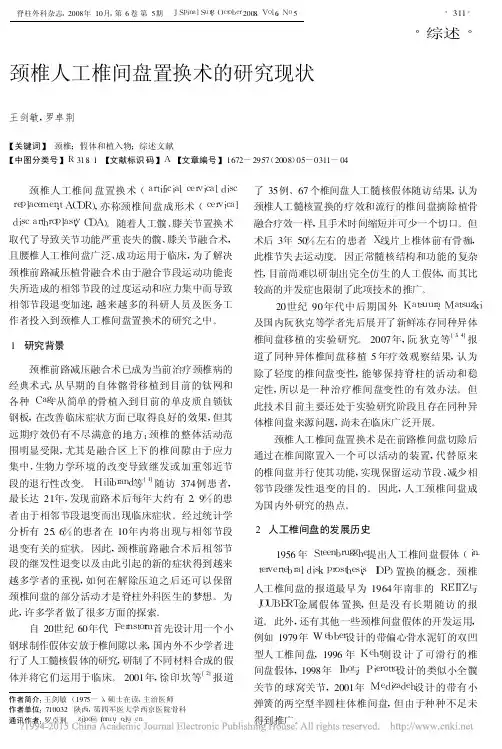
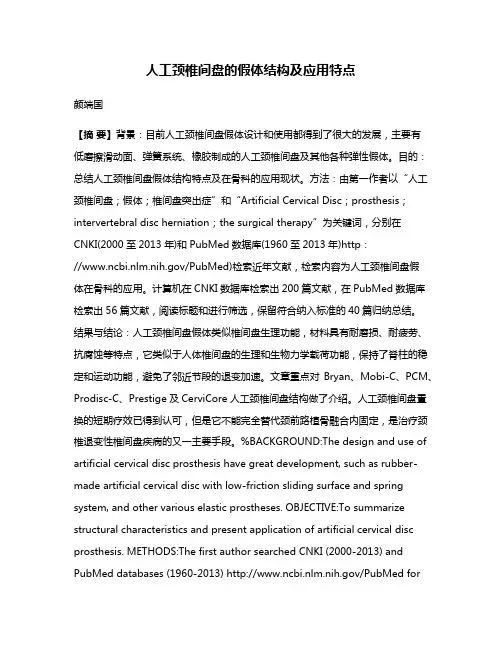
人工颈椎间盘的假体结构及应用特点颜端国【摘要】背景:目前人工颈椎间盘假体设计和使用都得到了很大的发展,主要有低磨擦滑动面、弹簧系统、橡胶制成的人工颈椎间盘及其他各种弹性假体。
目的:总结人工颈椎间盘假体结构特点及在骨科的应用现状。
方法:由第一作者以“人工颈椎间盘;假体;椎间盘突出症”和“Artificial Cervical Disc;prosthesis;intervertebral disc herniation;the surgical therapy”为关键词,分别在CNKI(2000至2013年)和PubMed数据库(1960至2013年)http:///PubMed)检索近年文献,检索内容为人工颈椎间盘假体在骨科的应用。
计算机在CNKI数据库检索出200篇文献,在PubMed数据库检索出56篇文献,阅读标题和进行筛选,保留符合纳入标准的40篇归纳总结。
结果与结论:人工颈椎间盘假体类似椎间盘生理功能,材料具有耐磨损、耐疲劳、抗腐蚀等特点,它类似于人体椎间盘的生理和生物力学载荷功能,保持了脊柱的稳定和运动功能,避免了邻近节段的退变加速。
文章重点对Bryan、Mobi-C、PCM、Prodisc-C、Prestige及CerviCore人工颈椎间盘结构做了介绍。
人工颈椎间盘置换的短期疗效已得到认可,但是它不能完全替代颈前路植骨融合内固定,是治疗颈椎退变性椎间盘疾病的又一主要手段。
%BACKGROUND:The design and use of artificial cervical disc prosthesis have great development, such as rubber-made artificial cervical disc with low-friction sliding surface and spring system, and other various elastic prostheses. OBJECTIVE:To summarize structural characteristics and present application of artificial cervical disc prosthesis. METHODS:The first author searched CNKI (2000-2013) and PubMed databases (1960-2013) /PubMed forliteratures on application of artificial cervical disc prosthesis. The key words included artificial cervical disc, prosthesis, intervertebral disc herniation, the surgical therapy. 200 literatures and 56 literatures were respectively searched in CNKI and the PubMed. Titles and abstracts were read. A total of 40 literatures were in accordance with inclusion criteria and included. RESULTS AND CONCLUSION:Artificial cervical disc prosthesis was consistent with physiological functions of intervertebral disk. The material is characterized by abrasion, fatigue resistance and corrosion resistance, is similar to physiological and biomechanical function of human disc, maintains the stability of the spine and motor function, and avoids the accelerated degeneration of adjacent segments. Articles mainly introduced the structure of Bryan, Mobi-C, PCM, Prodisc-C, Prestige and CerviCore artificial cervical disc. Short-period therapeutic effects of artificial cervical disc replacement have obtained approval. However, it cannot completely replace anterior cervical fusion, but is another manner to treat cervical degenerative disc disease.【期刊名称】《中国组织工程研究》【年(卷),期】2014(000)026【总页数】5页(P4260-4264)【关键词】植入物;人工假体;人工颈椎间盘;假体;颈椎病;椎间盘突出症;外科治疗【作者】颜端国【作者单位】监利县人民医院骨科,湖北省荆州市 434000【正文语种】中文【中图分类】R3180 引言 Introduction颈椎前路融合内固定是颈椎退行性疾病的经典手术方式,但是椎体节段融合后可能引起临近节段的生物力学变化,丢失颈椎关节活动度,可能加速邻近节段的椎间盘退变从而引起新的颈肩痛,而且有椎体不融合的风险,远期效果不如人意,加之近年来,对椎间盘的生物力学理论的认识不断深入,以及材料学的发展,许多学者认为,人工颈椎间盘假体置换符合椎间盘生理功能,材料具有耐磨损、耐疲劳、抗腐蚀等特点,是可能替代椎间盘融合治疗椎间盘退变性疾病的有效方法。
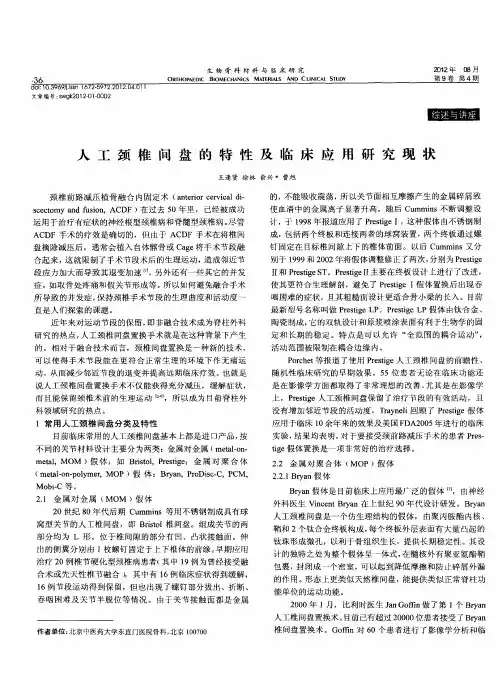
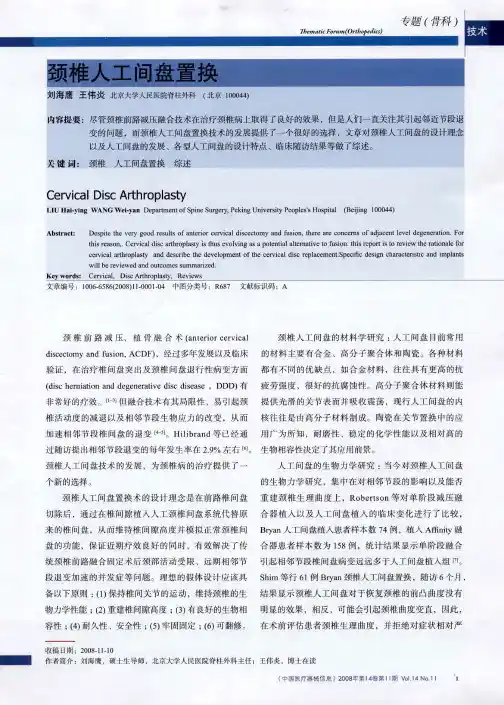
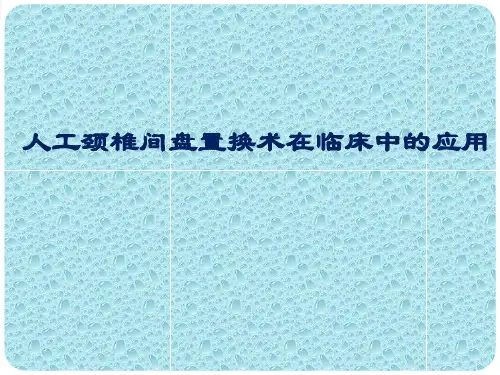
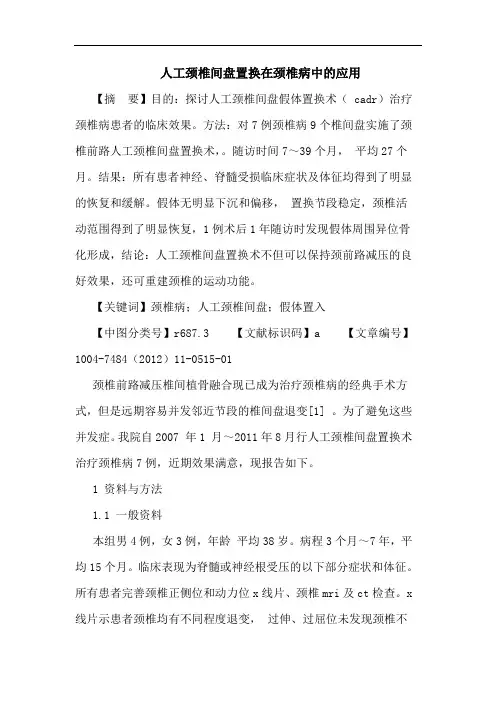
人工颈椎间盘置换在颈椎病中的应用【摘要】目的:探讨人工颈椎间盘假体置换术( cadr)治疗颈椎病患者的临床效果。
方法:对7例颈椎病9个椎间盘实施了颈椎前路人工颈椎间盘置换术,。
随访时间7~39个月,平均27个月。
结果:所有患者神经、脊髓受损临床症状及体征均得到了明显的恢复和缓解。
假体无明显下沉和偏移,置换节段稳定,颈椎活动范围得到了明显恢复,1例术后1年随访时发现假体周围异位骨化形成,结论:人工颈椎间盘置换术不但可以保持颈前路减压的良好效果,还可重建颈椎的运动功能。
【关键词】颈椎病;人工颈椎间盘;假体置入【中图分类号】r687.3 【文献标识码】a 【文章编号】1004-7484(2012)11-0515-01颈椎前路减压椎间植骨融合现已成为治疗颈椎病的经典手术方式,但是远期容易并发邻近节段的椎间盘退变[1] 。
为了避免这些并发症。
我院自2007 年1 月~2011年8月行人工颈椎间盘置换术治疗颈椎病7例,近期效果满意,现报告如下。
1 资料与方法1.1 一般资料本组男4例,女3例,年龄平均38岁。
病程3个月~7年,平均15个月。
临床表现为脊髓或神经根受压的以下部分症状和体征。
所有患者完善颈椎正侧位和动力位x线片、颈椎mri及ct检查。
x 线片示患者颈椎均有不同程度退变,过伸、过屈位未发现颈椎不稳, ct 及mr i 检查示患者均存在不同程度椎间盘退变和颈脊髓或神经根受压改变。
1.2 术前准备术前按常规颈椎前路准备,术前3~ 5 d 进行气管推移练习,以增强对术中牵拉的耐受力。
术前测量ct图像,根据测量结果和颈椎间盘模板确定的图像放大率预选相应的假体[2,3]。
患者术前均接受过3个月的系统保守治疗无效而进行手术治疗。
1.3 手术方法,全麻,仰卧中立位固定。
取右侧颈中横切口。
术中c型臂x射线机透视确认目标椎间盘,使目标椎间隙的上下椎体后缘在一条直线上,测量并记录椎间隙倾斜角度。
用尖刀和刮匙切除病变椎间盘,用球形磨钻去除相邻终板前缘的骨赘,使表面平整且目标椎间隙上下椎体前缘在一个平面上。
